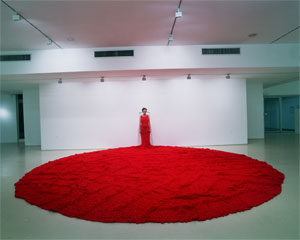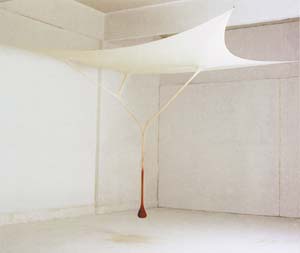Embroidered Action | Group Exhibition
Participating artists: Etti Abergel, Nelly Agassi, Erez Golan, Gal Weinstein, Masha Yozefpolsky, Michal Na’aman, Ernesto Neto, Ghada Amer, Alice Klingman, Chiharu Shiota

Embroidered Action is a group exhibition that explores various works of art based on the use of “soft” materials (thread, wool, fabric), synthetic materials (lycra, latex) and other “alternative” materials (paper, masking tape, steel wool) vis-à-vis “rigid” artistic contexts derived from the rudiments of the modernist perception as defined and established since the mid-20th century. The exhibition features the works of ten prominent contemporary artists, local and international, created in diverse media, including sculpture, photography, video, sound, installation and performance. The majority of the works on display were created especially for the show.

One may mark the beginning of the use of soft and/or alternative materials in the context of the western art world during the second half of the 20th century, as part of a broad cultural atmosphere that led to a sequence of attempts to breech and expand the familiar boundaries of art by means of diverse conceptual and physical actions. Within this frame, various artists during the 1960s and 1970s, in different places in the world simultaneously, began rethinking the materials of art on the one hand, and the structural array of its known institutions on the other. Many artists turned to new and alternative channels, among them conceptual art, earth art, body art, video art, etc., often yielding the very existence of the artistic object or its preservation in favor of the presence of the body or the abstract idea. The deviation from the bounds of conventional practices such as drawing, painting and sculpture, the use of unusual materials and the introduction of the moment of action were, thus, an integral part of the occurrences of the period.
Concurrently the use of soft and/or alternative materials began to surface. It is, however, important to indicate, if only on the most basic level, a certain split with regard to the use of these materials, and mainly with regard to the web of contexts derived from it.
On the one hand, one may note the use of materials such as wool, fabric, various types of rubber, etc., in the quintessential context of the modernist western art world. Standing out among the first artists to consciously employ alternative materials in their work is Eva Hesse, who as early as 1967 began using latex with the professed intention to expand and redefine the boundaries of her art and the concept of art in general.
On the other hand, the above-mentioned materials were used as part of corresponding work procedures (thread/sewing, wool/knitting, and so on), thus emphasizing a traditional female context, whether essential or cultural, or alternatively a tendency toward a dialogue with different cultures, historically ancient and geographically remote, in an attempt to undermine not only the basic definitions of western art, but also, mainly, the elitist, arrogant male tone that typified that practice and its discussion. Typical examples of such a frame of thought can be found in the work of Harmony Hammond or Judy Chicago, for instance.
This aspect of engagement with the material led, inter alia, to the evolution of artistic trends based on the choice of a specific material or given practice, such as fiber art or textile art. In these cases the material or operational dimension are not only a part of the process of creation, but also a central axis in structuring its meaning. This current habitually relied on the basic assumption that material as such possesses a given immanent meaning, and hence – that the very choice of a specific material, and certainly its use vis-à-vis an old tradition, embody a profound political and cultural meaning. Leading artists who operated along these lines are Sheila Hicks and Magdalena Abakanowicz, for example.
The artists participating in Embroidered Action are characterized by their conscious use of a wide scope of materials that does not settle into the structured array of existing contexts. Despite the distinctive use of soft and/or alternative materials, the exhibited works deviate from the relatively small-scale typical of traditional “female art” (the so-called lap work), and the stereotypical range of themes that has been tied to the use of materials such as thread, wool, fabric etc. over the years, a narrative thematic range of themes that generally touched upon “female,” domestic or cultural issues.
Unraveling the categorical identification pertaining to the use of these materials and procedures of operation, such as embroidery, sewing, knitting, wrapping, tying or gluing, allows the participating artists not only to criticize, expand and develop the potential of meaning ostensibly embodied in them a-priori (as done by various feminist artists over the years), but also, mainly, to depart from it and formulate a new range of meanings that endeavors to bind different formal, material and conceptual values, while intersecting diverse, at times antithetical fields of discourse and activity.
Thus, for example, one may discern that the structure of the grid, in its various material manifestations, recurs in many of the works in the show, albeit in a manner that thwarts a direct link to the principles of modernism and minimalism of the previous century. These principles deflected artistic practice toward the abstract and constituted a creation/display code that was based on the aspiration for objectivity, neutral anonymity, lack of narrative, and a continual rejection of expressive and decorative elements. Many works from the minimalist period were based on quasi-pure geometric forms or fixed grid patterns, not only as structural bases, but as elements that articulated the very essence of the representational and utopian affinity between nature and culture most clearly and succinctly.
In the current show, on the other hand, the grid emerges in disrupted form, materially processed and conceptually channeled, serving as a vehicle in the formation of a specific essence, rather than as a utopian reflection of the ostensibly natural one. The artists participating in the show explore questions of space and exhibition context, matter and experience, while the perception of art as an extended act and not only as a delineated move of processing material or creating form, is an important element in the understanding of their work.
Thus, the works in the show maintain a fine, yet acute, tension between a quintessentially conceptual infrastructure and a refined expressive tone that is not pushed outside the frame of work. The severe control of the means of expression on the one hand, and the incorporation of time and movement on the other, generate a situation where the expressive penetrates the conceptual, the physical invades the abstract, and the personal is blended with the principal.
Hadas Maor
Exhibition Curator
Aditional Exhibitions
-
Zeev Engelmayer | The Daily Postcard
Zeev Engelmayer | The Daily Postcard
-
Be’eri Plant Bed
Hosted Project
Curator: Nivi Lehavi
-
Structures
Weaving in Israel, from Functionalism to Fiber Art Group exhibition
Curator: Dr. Noga Bernstein | Assistant Curator: Aya Armoni
-
Gur Inbar
Yarn of Clay
Curator: Galit Gaon | Assistant curator: Tzafi Sivan Spivak
-
Fatima Abu Roomi
Close to Herself
Curator: Prof. Yael Guilat
-
Siona Shimshi
Textile Patterns in Her Own Hand
Curator: Yuval Etzioni
-
Eternal Spring
Mambush Tapestry Workshop, Ein Hod, 1966–1985
Curator: Zeela Kotler Hadari | Assistant Curator: Yuval Keshet
This is a test-run of the website, thanks for your patience! Your input is welcome. info-museum@herzliya.muni.il </ strong>